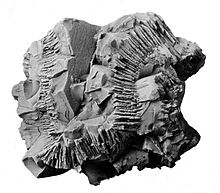Pyrolusite
| Pyrolusite | |
|---|---|
 | |
| General | |
| Category | Oxide minerals |
| Formula (repeating unit) | MnO2 |
| IMA symbol | Pyl[1] |
| Strunz classification | 4.DB.05 |
| Crystal system | Tetragonal |
| Crystal class | Ditetragonal dipyramidal (4/mmm) H-M symbol:(4/m 2/m 2/m) |
| Space group | P42/mnm |
| Identification | |
| Color | Darkish, black to lighter grey, sometimes bluish |
| Crystal habit | Granular to massive: botryoidal. Crystals rare |
| Twinning | {031}, {032} may be polysynthetic |
| Cleavage | Perfect on 110 |
| Fracture | Irregular/Uneven |
| Tenacity | Brittle |
| Mohs scalehardness | 6–6.5, 2 when massive |
| Luster | Metallic, dull to earthy |
| Streak | Black to bluish-black |
| Specific gravity | 4.4–5.06 |
| Refractive index | Opaque |
| References | [2][3][4][5] |
| Major varieties | |
| Polianite | pseudomorphic aftermanganite[6] |
Pyrolusiteis amineralconsisting essentially ofmanganese dioxide(MnO2) and is important as anoreof manganese.[7]It is a black,amorphousappearing mineral, often with a granular, fibrous, or columnar structure, sometimes formingreniformcrusts. It has a metallicluster,a black or bluish-black streak, and readily soils the fingers. Thespecific gravityis about 4.8. Its name is from the Greek forfireand towash,in reference to its use as a way to remove tints from glass.[5]

Occurrence[edit]

Pyrolusite andromanechiteare among the most common manganese minerals. Pyrolusite occurs associated withmanganite,hollandite,hausmannite,braunite,cryptomelane,chalcophanite,goethite,andhematiteunderoxidizingconditions inhydrothermaldeposits. It also occurs inbogsand often results from alteration of manganite.[5]
Use[edit]
The metal is obtained by reduction of the oxide withsodium,magnesium,aluminium,or byelectrolysis.Pyrolusite is extensively used for the manufacture ofspiegeleisenandferromanganeseand of various alloys such as manganese-bronze.As an oxidizing agent it is used in the preparation ofchlorine;indeed, chlorine gas itself was first described byKarl Scheelein 1774 from the reaction products of pyrolusite andhydrochloric acid.Natural pyrolusite has been used in batteries, but high-quality batteries requiresynthetic products.Pyrolusite is also used to prepare disinfectants (permanganates) and for decolorizing glass. When mixed with molten glass it oxidizes the ferrousironto ferric iron, and so discharges the green and brown tints (making it classically useful to glassmakers as a decolorizer). As a coloring material, it is used in calico printing and dyeing; for imparting violet,amber,and black colors to glass, pottery, and bricks; and in the manufacture of green and violet paints.
Dendritic manganese oxides[edit]
Black, manganese oxides with adendriticcrystal habitoften found on fracture or rock surfaces are often assumed to be pyrolusite although careful analyses of numerous examples of these dendrites has shown that none of them are, in fact, pyrolusite. Instead, they are other forms of manganese oxide.[8][9]
History[edit]
Some of the most famous early cave paintings in Europe were executed by means of manganese dioxide. Blocks of pyrolusite are found often atNeanderthalsites. It may have been kept as a pigment forcave paintings,but it has also been suggested that it was powdered and mixed withtinder fungusfor lighting fires.[10]Manganese dioxide, in the form ofumber,was one of the earliest natural substances used by human ancestors. It was used as apigmentat least from theMiddle Paleolithic.It may have been also used by theNeanderthalsin fire-making.[11]
The ancient Greeks had a term μάγνης or Μάγνης λίθος ( "Magnes lithos" ) meaning stone of the area called Μαγνησία (Magnesia), referring toMagnesia in Thessalyor to areas inAsia Minorwith that name. Two minerals are called μάγνης, namelylodestoneand pyrolusite (manganese dioxide). Later the term μαγνησία was used for manganese dioxide. In the sixteenth century it was called "manganesum". It also was called Alabandicus (from theAlabandaregion of Asia Minor) and Braunstein. Eventually the name of the element manganese was derived from "manganesum", whereas "magnesia" came to mean the oxide of a different element,magnesium.[12]
See also[edit]
Other manganese oxides:
References[edit]
- ^Warr, L.N. (2021)."IMA–CNMNC approved mineral symbols".Mineralogical Magazine.85(3): 291–320.Bibcode:2021MinM...85..291W.doi:10.1180/mgm.2021.43.S2CID235729616.
- ^Mineralienatlas
- ^Barthelmy, David (2014)."Pyrolusite Mineral Data".Webmineral.com.Retrieved4 August2022.
- ^Pyrolusite,Mindat.org,retrieved4 August2022
- ^abcAnthony, John W.; Bideaux, Richard A.; Bladh, Kenneth W.; Nichols, Monte C. (2005)."Pyrolusite"(PDF).Handbook of Mineralogy.Mineral Data Publishing.Retrieved14 March2022.
- ^Polianite,Mindat.org,retrieved4 August2022
- ^Reidies, Arno H. (2002), "Manganese Compounds",Ullmann's Encyclopedia of Industrial Chemistry,vol. 20, Weinheim: Wiley-VCH, pp. 495–542,doi:10.1002/14356007.a16_123,ISBN978-3-527-30385-4.
- ^Potter, Russell M. and Rossman, George R. (1979)Mineralogy of manganese dendrites and coatings.American Mineralogist, 64 (11-12). pp. 1219–1226
- ^Mn dendrites on Mindat
- ^Michael Le Page (Jul 28, 2018)."The original fire starters".New Scientist.239(3188): 14.Bibcode:2018NewSc.239...14L.doi:10.1016/S0262-4079(18)31336-8.S2CID240486296.
- ^Heyes, Peter J.; Anastasakis, Konstantinos; De Jong, Wiebren; Van Hoesel, Annelies; Roebroeks, Wil; Soressi, Marie (2016)."Selection and Use of Manganese Dioxide by Neanderthals".Scientific Reports.6:22159.doi:10.1038/srep22159.PMC4770591.PMID26922901.
- ^Calvert, J. B. (24 January 2003)."Chromium and Manganese".Archived fromthe originalon 31 December 2016.
This article incorporates text from a publication now in thepublic domain:Chisholm, Hugh,ed. (1911). "Pyrolusite".Encyclopædia Britannica.Vol. 22 (11th ed.). Cambridge University Press. p. 693.
